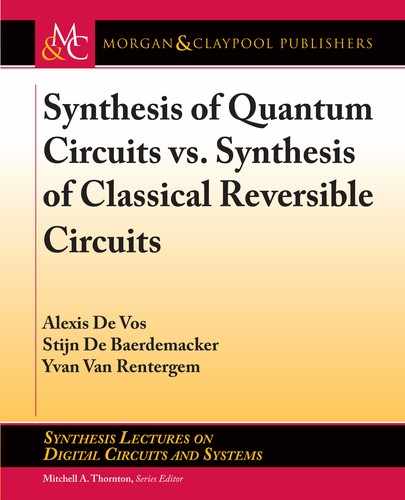
58 3. BOTTOM-UP
3.4 NEGATOR CIRCUITS
Two-qubit circuits are represented by matrices from U(4). We may apply either the NEGATOR
gate or the PHASOR gate from the previous section to either the first qubit or the second qubit.
Here are two examples:
ˆ./
and
N./
;
in other words, a PHASOR acting on the first qubit and a NEGATOR acting on the second qubit,
respectively. ese circuits are represented by the 4 4 unitary matrices
0
B
B
@
1 0 0 0
0 1 0 0
0 0 e
i
0
0 0 0 e
i
1
C
C
A
and
0
B
B
B
@
1
2
.1 C e
i
/
1
2
.1 e
i
/ 0 0
1
2
.1 e
i
/
1
2
.1 C e
i
/ 0 0
0 0
1
2
.1 C e
i
/
1
2
.1 e
i
/
0 0
1
2
.1 e
i
/
1
2
.1 C e
i
/
1
C
C
C
A
;
respectively.
However, we also introduce the controlled PHASORs and the controlled NEGATORs. Two
examples are
N./
and
ˆ./
;
i.e., a positive polarity controlled NEGATOR acting on the first qubit, controlled by the second
qubit, and a negative polarity controlled PHASOR acting on the second qubit, controlled by the
first qubit, respectively. e former symbol is read as follows: “if the second qubit equals 1, then
the NEGATOR acts on the first qubit; if, however, the second qubit equals 0, then the NEGATOR
is inactive, i.e., the first qubit undergoes no change.” e latter symbol is read as follows: “if
the first qubit equals 0, then the PHASOR acts on the second qubit; if, however, the first qubit
equals 1, then the PHASOR is inactive, i.e., the second qubit undergoes no change.” e matrices
representing these circuit examples are:
0
B
B
@
1 0 0 0
0
1
2
.1 C e
i
/ 0
1
2
.1 e
i
/
0 0 1 0
0
1
2
.1 e
i
/ 0
1
2
.1 C e
i
/
1
C
C
A
and
0
B
B
@
1 0 0 0
0 e
i
0 0
0 0 1 0
0 0 0 1
1
C
C
A
;
respectively.
We now give two examples of a 3-qubit circuit:
N./
and
ˆ./
;

3.4. NEGATOR CIRCUITS 59
i.e., a positive polarity controlled NEGATOR acting on the first qubit and a mixed polarity con-
trolled PHASOR acting on the third qubit. e 8 8 matrices representing these circuit examples
are:
0
B
B
B
B
B
B
B
B
B
B
B
@
1 0 0 0 0 0 0 0
0 1 0 0 0 0 0 0
0 0 1 0 0 0 0 0
0 0 0
1
2
.1 C e
i
/ 0 0 0
1
2
.1 e
i
/
0 0 0 0 1 0 0 0
0 0 0 0 0 1 0 0
0 0 0 0 0 0 1 0
0 0 0
1
2
.1 e
i
/ 0 0 0
1
2
.1 C e
i
/
1
C
C
C
C
C
C
C
C
C
C
C
A
and
0
B
B
B
B
B
B
B
B
B
B
B
@
1 0 0 0 0 0 0 0
0 1 0 0 0 0 0 0
0 0 1 0 0 0 0 0
0 0 0 e
i
0 0 0 0
0 0 0 0 1 0 0 0
0 0 0 0 0 1 0 0
0 0 0 0 0 0 1 0
0 0 0 0 0 0 0 1
1
C
C
C
C
C
C
C
C
C
C
C
A
;
respectively. We note the following properties:
• the former matrix has all eight row sums and all eight column sums equal to 1 and
• the latter matrix is diagonal and has upper-left entry equal to 1.
Because the multiplication of two square matrices with all line sums equal to 1 automat-
ically yields a third square matrix with all line sums equal to 1, we can easily demonstrate that
an arbitrary quantum circuit like
;
consisting merely of uncontrolled NEGATORs and controlled NEGATORs, is represented by a
2
w
2
w
unitary matrix with all line sums equal to 1. e n n unitary matrices with all line sums
equal to 1 form a group XU(n), subgroup of U(n). We thus can say that an arbitrary NEGATOR
circuit is represented by an XU(2
w
) matrix. e converse theorem is also valid: any member X
of XU(2
w
) can be synthesized by an appropriate string of (un)controlled NEGATORs. e labo-
rious proof [54] of this fact is based on the Hurwitz decomposition [55, 56] of an arbitrary
matrix U of the unitary group U(2
w
1). Such decomposition contains .2
w
1/ .2
w
1/
matrices belonging to four different simple categories. is leads to a decomposition of the
2
w
2
w
matrix X into simple factors. It then suffices to prove the theorem for each of the four
categories separately.
Because the multiplication of two diagonal square matrices yields a third diagonal square
matrix and because the multiplication of two unitary matrices with first entry equal to 1 yields
a third unitary matrix with first entry equal to 1, an arbitrary quantum circuit like
;
..................Content has been hidden....................
You can't read the all page of ebook, please click here login for view all page.
